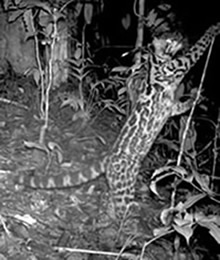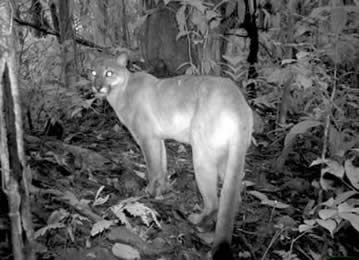See News & Updates from Arbogast Lab
Mammal Biodiversity and Conservation in the tropical Andes of Ecuador

We are working with colleagues from Francis Marion Univeristy --Travis Knowles , Jeff Camper and Natasha Vanderhoff (now at Jacksonville University) and Anne-Marie Hodge (UNCW) to study vertebrate biodiversity and conservation at the Wildsumaco Wildlife Sanctuary, adjacent to the Sumaco National Park and World Biosphere Reserve on the eastern slope of the Andes in Ecuador. We are in our 3rd year of using camera-traps to study the large and medium-sized mammal biodiversity at the site. UNCW Graduate Students, Anne-Marie Hodge and Kai Curry-Lindahl, have been using camera-traps to study the medium and large mammals at Wildsumaco and the adjacent Sumaco Napo-Galeras National Park. Anne-Marie's work has focused on documenting and understanding spatial and temporal partitioning of resources in the diverse assemblage of carnivores in the area; she has also been conducting a detailed study on the margay (shown below left). Kai's research is focused on mammalian diversity in the higher elevation cloud forests of Sumaco National Park.
For a reecent article on the margay, see:


Biogeography & Conservation Genetics of Gliding Mammals
A major focus of reseach in my lab is the biogeography and conservation genetics of gliding mammals. I have worked most extensively on flying squirrels. Like most gliders, flying squirrels are so highly adapted to life in the forest canopy that they can’t persist in unforested areas. Although they do routinely come to the ground to forage, they are not likely to move across large open areas. As a result, they are sensitive to the creation of gaps in forest habitats. On an evolutionary time scale, this means that changes in the distribution of forests have had a profound effect on the biogeography of flying squirrels. On an ecological time scale, this means that flying squirrel movement and distribution patterns are strongly influenced by natural and human-induced forest fragmentation.

UNCW Graduate Student, Katelyn Schumacher, has been studying the landscape and conservation genetics of endangered populations of the northern flying squirrel in the central and southern Appalachian mountains. She has been combining microsattelite and mtDNA with GIS to map how populations are related to one another throughout the region.
My former Graduate Student, Nick Kerhoulas, extended our large-scale biogeographic studies of Glaucomys to include the flying squirrels of Mexico and Central America. He used DNA obtained from museum study skins to see how these populations are related to those in North America, and to better understand the biogeography of the New World flying squirrels and the forests they inhabit.
See: Kerhoulas, N. J. and B. S. Arbogast. 2010. Molecular Systematics and Pleistocene
Biogeography of Mesoamerican Flying Squirrels. Journal of Mammalogy 91: 654-667.
I am also collaborating with Andrea Taylor of Monash University and Ken Aplin of the Australian National Wildlife Collection/CSIRO to study the conservation genetics and biogeography of the world’s largest gliding marsupial, the greater glider, Petauroides volans..








